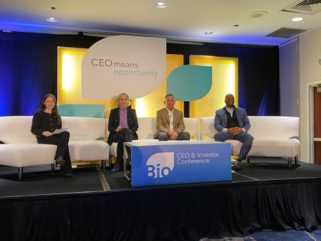Operational risks with gene therapies should improve with time, exec says
28 Feb 2024
Gene Therapy

Preview
Source: Pharmaceutical Technology
Panelists from left to right: MeiraGTx CEO Alexandra Forbes, Jaguar Gene Therapy CEO Joe Nolan, and Lexeo Therapeutics CEO Nolan Townsend. Credit: Justine Ra/GlobalData
With gene therapy programs, it is challenging to maintain the balancing act between the benefit and risk of a given indication, explained Nolan Townsend, CEO of Lexeo Therapeutics.
Townsend was speaking at the two-day 2024 BIO CEO & Investor Conference in New York conference. On 6 February, scalability and development were the stars of discussions, with experts outlining the various factors involved in developing gene therapies.
There has been a progression in development from small, orphan monogenic diseases into areas of higher risk and unmet need that can encompass disease states that are harder to treat, said Joe Nolan, CEO of the US-based biotech Jaguar Gene Therapy
The gene therapy field has experienced more clinical holds than both biologics and small molecules because there were many unanswered questions on the ideal chemistry, manufacturing, and controls (CMC), dosage, immune suppression regimen, and routes of administration, said Townsend. But as the field has begun answering these questions, the risk profile of gene therapies will substantially decrease over time, he added.
Aside from the balance of benefit and risk, another important consideration when developing gene therapies is determining how optimised the technology is to address a particular indication and how minimal a dose a patient can receive, said Alexandra Forbes, CEO of MeiraGTx. She provided an example of how MeiraGTx Parkinson’s program takes into account the smallest possible dosage and in turn, is associated with a lower cost of goods.

Preview
Source: Pharmaceutical Technology
AbbVie licenses OSE’s chronic inflammation therapy for $48m upfront

Preview
Source: Pharmaceutical Technology
Providing a product at a price that the market can afford is essential, Forbes said. In addition, there needs to be a heavy emphasis on the budget impact of a given disease to move toward developing a cost-saving gene therapy, added Townsend.
Manufacturing is critical for therapy development
“Manufacturing your gene therapy is essential to your entire clinical development,” explained Forbes. MeiraGTx built its own facility as a startup because the processes required for the company’s biologics license application (BLA) study were not broadly available across CMOs at the time of study. The benefit of having manufacturing capacity/capability is the facilitation of commercialisation and scalability, with the bonus of established regulatory interactions and positive impact on cost of goods, she added.
However, it is difficult to find people who understand the level of detail required when manufacturing commercially viable gene therapy product, Nolan said.
The future of the gene therapy field lies in commercial-scale processes that are used in products like biologics, especially as technology catches up to the commercial demands of gene therapy indications, said Townsend.
For more details,please visit the original website
The content of the article does not represent any opinions of Synapse and its affiliated companies. If there is any copyright infringement or error, please contact us, and we will deal with it within 24 hours.
Organizations
Indications
Targets
-Drugs
-Hot reports
Get started for free today!
Accelerate Strategic R&D decision making with Synapse, PatSnap’s AI-powered Connected Innovation Intelligence Platform Built for Life Sciences Professionals.
Start your data trial now!
Synapse data is also accessible to external entities via APIs or data packages. Leverages most recent intelligence information, enabling fullest potential.





